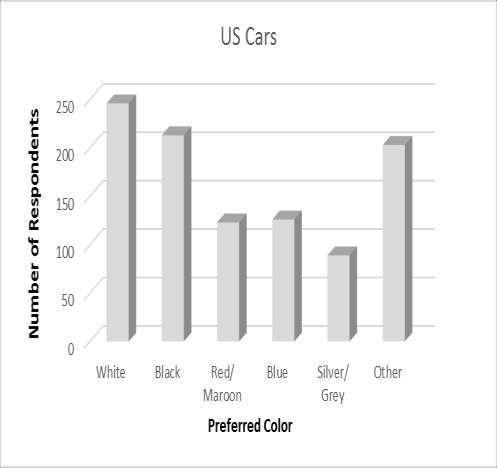
24 minute read
Test Bank for Business Statistics For Contemporary Decision
from Test bank for business statistics for contemporary decision making 8th edition by black isbn 1118494
Making 8th Edition by Black ISBN 1118494768
9781118494769
Advertisement
Full link download
Test bank: https://testbankpack.com/p/test-bank-for-businessstatistics-for-contemporary-decision-making-8th-edition-by-blackisbn-1118494768-9781118494769/
Solution Manual: https://testbankpack.com/p/solution-manual-forbusiness-statistics-for-contemporary-decision-making-8th-edition-byblack-isbn-1118494768-9781118494769/
True/False
1. A summary of data in which raw data are grouped into different intervals and the number of items in each group is listed is called a frequency distribution.
Ans: True
Response: See section 2.1 Frequency Distributions
Difficulty: Easy
Learning Objective: 2.1: Construct a frequency distribution from a set of data.
2. If the individual class frequencyis divided by the total frequency, the result is the median frequency.
Ans: False
Response: See section 2.1 Frequency Distributions
Difficulty: Medium
Learning Objective: 2.1: Construct a frequency distribution from a set of data.
3. A cumulative frequency distribution provides a running total of the frequencies in the classes.
Ans: True
Response: See section 2 1 Frequency Distributions
Difficulty: Medium
Learning Objective: 2.1: Construct a frequency distribution from a set of data.
4. The difference between the highest number and the lowest number in a set of data is called the differential frequency
Ans: False
Response: See section 2 1 Frequency Distributions
Difficulty: Medium
Learning Objective: 2.1: Construct a frequency distribution from a set of data.
5. For any given data set, a frequency distribution with a larger number of classes will always be better than the one with a smaller number of classes.
Ans: False
Response: See section 2.1 Frequency Distributions
Difficulty: Medium
Learning Objective: 2.1: Construct a frequency distribution from a set of data.
6. One rule that must always be followed in constructing frequency distributions is that the adjacent classes must overlap.
Ans: False
Response: See section 2.1 Frequency Distributions
Difficulty: Medium
Learning Objective: 2.1: Construct a frequency distribution from a set of data.
7. An instructor made a frequency table of the scores his students got on a test a) 90 b) 5 c) 95 d) 100 e) 50
The midpoint of the last class interval is .
Ans: c
Response: See section 2.1 Frequency Distributions
Difficulty: Easy
Learning Objective: 2.1: Construct a frequency distribution from a set of data.
8. An instructor made a frequency table of the scores his students got on a test a) 36 b) 20 c) 50 d) 10 e) 64
Approximatelywhat percent of students got more than 70?
Ans: e
Response: See section 2.1 Frequency Distributions
Difficulty: Easy
Learning Objective: 2.1: Construct a frequency distribution from a set of data.
9. A cumulative frequency polygon is also called an ogive.
Ans: True
Response: See section 2.2 Quantitative Data Graphs
Difficulty: Medium
Learning Objective: 2.2: Construct different types of quantitative data graphs, including histograms, frequency polygons, ogives, dot plots, and stem-and-leaf plots, in order to interpret the data being graphed.
10. A histogram can be described as a type of vertical bar chart.
Ans: True
Response: See section 2.2 Quantitative Data Graphs
Difficulty: Medium
Learning Objective: 2.2: Construct different types of quantitative data graphs, including histograms, frequency polygons, ogives, dot plots, and stem-and-leaf plots, in order to interpret the data being graphed.
11. One advantage of a stem and leaf plot over a frequency distribution is that the values of the original data are retained.
Ans: True
Response: See section 2 2 Quantitative Data Graphs
Difficulty: Medium
Learning Objective: 2.2: Construct different types of quantitative data graphs, including histograms, frequency polygons, ogives, dot plots, and stem-and-leaf plots, in order to interpret the data being graphed.
12. For a company in gardening supplies business, the best graphical way to show the percentage of a total budget that is spent on each of a number of different expense categories is the stem and leaf plot.
Ans: False
Response: See section 2.2 Quantitative Data Graphs
Difficulty: Hard
Learning Objective: 2.2: Construct different types of quantitative data graphs, including histograms, frequency polygons, ogives, dot plots, and stem-and-leaf plots, in order to interpret the data being graphed.
13. In a histogram, the tallest bar represents the class with the highest cumulative frequency.
Ans: False
Response: See section 2.2 Quantitative Data Graphs
Difficulty: Medium
Learning Objective: 2.2: Construct different types of quantitative data graphs, including histograms, frequency polygons, ogives, dot plots, and stem-and-leaf plots, in order to interpret the data being graphed.
14. Dot Plots are mainly used to display a large data set.
Ans: False
Response: See section 2.2 Quantitative Data Graphs
Difficulty: Medium
Learning Objective: 2.2: Construct different types of quantitative data graphs, including histograms, frequency polygons, ogives, dot plots, and stem-and-leaf plots, in order to interpret the data being graphed.
15. A graphical representation of a frequency distribution is called a pie chart.
Ans: False
Response: See section 2 3 Qualitative Data Graphs
Difficulty: Easy
Learning Objective: 2.3: Construct different types of qualitative data graphs, including pie charts, bar graphs, and Pareto charts, in order to interpret the data being graphed.
16. In contrast to quantitative data graphs that are plotted along a numerical scale, qualitative graphs are plotted using non-numerical categories.
Ans: True
Response: See section 2.3 Qualitative Data Graphs
Difficulty: Easy
Learning Objective: 2.3: Construct different types of qualitative data graphs, including pie charts, bar graphs, and Pareto charts, in order to interpret the data being graphed.
17. A Pareto chart and a pie chart are both types of qualitative graphs.
Ans: True
Response: See section 2.3 Qualitative Data Graphs
Difficulty: Easy
Learning Objective: 2.3: Construct different types of qualitative data graphs, including pie charts, bar graphs, and Pareto charts, in order to interpret the data being graphed.
18. A scatter plot shows how the numbers in a data set are scattered around their average.
Ans: False
Response: See section 2 4 Charts and Graphs for Two Variables.
Difficulty: Medium
Learning objective: 2.4: Recognize basic trends in two-variable scatter plots of numerical data.
19. A scatter plot is a two-dimensional graph plot of data containing pairs of observations on two numerical variables.
Ans: True
Response: See section 2.4 Charts and Graphs for Two Variables
Difficulty: Medium
Learning objective: 2.4: Recognize basic trends in two-variable scatter plots of numerical data.
20. A scatter plot is useful for examining the relationship between two numerical variables.
Ans: True
Response: See section 2 4 Charts and Graphs for Two Variables
Difficulty: Medium
Learning objective: 2.4: Recognize basic trends in two-variable scatter plots of numerical data.
Multiple Choice
21. Consider the following frequency distribution: Class
30-under 40 10 a) 10 b) 20 c) 15 d) 30 e) 40
What is the midpoint of the first class?
Ans: c
Response: See section 2 1 Frequency Distributions
Difficulty: Easy
Learning Objective: 2.1: Construct a frequency distribution from a set of data.
22. Consider the following frequency distribution: Class
20-under 30 25
30-under 40 10 a) 0.15 b) 0.30 c) 0.10 d) 0.20 e) 0.40
Ans: b
Response: See section 2.1 Frequency Distributions
Difficulty: Medium
Learning Objective: 2.1: Construct a frequency distribution from a set of data.
23. Consider the following frequency distribution: Class Interval Frequency
10-under 20 15
20-under 30 25
30-under 40 10 a) 25 b) 40 c) 15 d) 50
Ans: b
Response: See section 2.1 Frequency Distributions
Difficulty: Medium a) 80 b) 100 c) 95 d) 90 e) 85
Learning Objective: 2.1: Construct a frequency distribution from a set of data.
24. The number of phone calls arriving at a switchboard each hour has been recorded, and the following frequency distribution has been developed.
What is the midpoint of the last class?
Ans: d
Response: See section 2 1 Frequency Distributions
Difficulty: Easy a) 0.455 b) 0.900 c) 0.225 d) 0.750 e) 0.725
Learning Objective: 2.1: Construct a frequency distribution from a set of data.
25. The number of phone calls arriving at a switchboard each hour has been recorded, and the following frequency distribution has been developed.
Ans: c
Response: See section 2 1 Frequency Distributions
Difficulty: Medium a) 80 b) 0.40 c) 155 d) 75 e) 105
Learning Objective: 2.1: Construct a frequency distribution from a set of data.
26. The number of phone calls arriving at a switchboard each hour has been recorded, and the following frequency distribution has been developed.
Ans: c
Response: See section 2.1 Frequency Distributions
Difficulty: Medium a) 4 b) 12 c) 8 d) 5 e) 9
Learning Objective: 2.1: Construct a frequency distribution from a set of data.
27 A person has decided to construct a frequency distribution for a set of data containing 60 numbers. The lowest number is 23 and the highest number is 68. If 5 classes are used, the class width should be approximately .
Ans: e
Response: See section 2 1 Frequency Distributions
Difficulty: Easy a) 5 b) 7 c) 9 d) 11 e) 12
Learning Objective: 2.1: Construct a frequency distribution from a set of data.
28. A person has decided to construct a frequency distribution for a set of data containing 60 numbers. The lowest number is 23 and the highest number is 68. If 7 classes are used, the class width should be approximately .
Ans: b
Response: See section 2 1 Frequency Distributions
Difficulty: Medium a) 9.50 b) 9.60 c) 9.70 d) 9.40 e) 9.80
Learning Objective: 2.1: Construct a frequency distribution from a set of data.
29. A frequency distribution was developed. The lower endpoint of the first class is 9.30, and the midpoint is 9.35. What is the upper endpoint of this class?
Ans: d
Response: See section 2 1 Frequency Distributions
Difficulty: Medium
Learning Objective: 2.1: Construct a frequency distribution from a set of data.
30. The cumulative frequency for a class is 27. The cumulative frequency for the next (nonempty) class will be a) less than 27 b) equal to 27 c) next class frequencyminus 27 d) 27 minus the next class frequency e) 27 plus the next class frequency
Ans: e
Response: See section 2.1 Frequency Distributions
Difficulty: Hard
Learning Objective: 2.1: Construct a frequency distribution from a set of data.
31. The following class intervals for a frequency distribution were developed to provide information regarding the starting salaries for students graduating from a particular school:
28-under 31 -
31-under 35 -
34-under 37 -
39-under 40 - a) There are too many intervals. b) The class widths are too small. c) Some numbers between 28,000 and 40,000 would fall into two different intervals. d) The first and the second interval overlap. e) There are too few intervals.
Before data was collected, someone questioned the validity of this arrangement. Which of the following represents a problem with this set of intervals?
Ans: c
Response: See section 2.1 Frequency Distributions
Difficulty: Medium
Learning Objective: 2.1: Construct a frequency distribution from a set of data.
32. The following class intervals for a frequency distribution were developed to provide information regarding the starting salaries for students graduating from a particular school: Salary Number of Graduates
($1,000s)
28-under 31 -
31-under 35 -
34-under 37 -
39-under 40 - a) There are too many intervals. b) The class widths are too small. c) Some numbers between 28,000 and 40,000 would not fall into any of these intervals. d) The first and the second interval overlap. e) There are too few intervals.
Before data was collected, someone questioned the validity of this arrangement. Which of the following represents a problem with this set of intervals?
Ans: c
Response: See section 2.1 Frequency Distributions
Difficulty: Hard
Learning Objective: 2.1: Construct a frequency distribution from a set of data.
33. The following class intervals for a frequency distribution were developed to provide information regarding the starting salaries for students graduating from a particular school: Salary Number of Graduates
($1,000s)
28-under 31 -
31-under 35 -
34-under 37 -
39-under 340 - a) There are too many intervals. b) The class widths are too small. c) The class widths are too large. d) The second and the third interval overlap. e) There are too few intervals.
Before data was collected, someone questioned the validity of this arrangement. Which of the following represents a problem with this set of intervals?
Ans: d
Response: See section 2 1 Frequency Distributions
Difficulty: Medium
Learning Objective: 2.1: Construct a frequency distribution from a set of data.
34. Abel Alonzo, Director of Human Resources, is exploring employee absenteeism at the Harrison Haulers Plant during the last operating year. A review of all personnel records indicated that absences ranged from zero to twenty-nine days per employee. The following class intervals were proposed for a frequency distribution of absences.
5
10
10-under 15
20-under 25
25-under 30 a) There are too few intervals. b) Some numbers between 0 and 29, inclusively, would not fall into any interval. c) The first and second interval overlaps. d) There are too manyintervals. e) The second and the third interval overlap.
Ans: b
Response: See section 2 1 Frequency Distributions
Difficulty: Medium
Learning Objective: 2.1: Construct a frequency distribution from a set of data.
35. Abel Alonzo, Director of Human Resources, is exploring employee absenteeism at the Harrison Haulers Plant during the last operating year. A review of all personnel records indicated that absences ranged from zero to twenty-nine days per employee. The following class intervals were proposed for a frequency distribution of absences.
10
10-under 20
20-under 30 a) There are too few intervals. b) Some numbers between 0 and 29 would not fall into any interval. c) The first and second interval overlaps. d) There are too manyintervals. e) The second and the third interval overlap.
Which of the following might represent a problem with this set of intervals?
Ans: a
Response: See section 2.1 Frequency Distributions
Difficulty: Medium
Learning Objective: 2.1: Construct a frequency distribution from a set of data.
36. Consider the relative frequency distribution given below: a) 12 b) 20 c) 40 d) 10 e) 15
There were 60 numbers in the data set. How many numbers were in the interval 20-under 40?
Ans: a
Response: See section 2.1 Frequency Distributions
Difficulty: Easy
Learning Objective: 2.1: Construct a frequency distribution from a set of data.
37. Consider the relative frequency distribution given below: a) 30 b) 50 c) 18 d) 12 e) 15
There were 60 numbers in the data set. How many numbers were in the interval 40-under 60?
Ans: c
Response: See section 2 1 Frequency Distributions
Difficulty: Easy
Learning Objective: 2.1: Construct a frequency distribution from a set of data.
38. Consider the relative frequency distribution given below: a) 90 b) 80 c) 0.9 d) 54 e) 100
There were 60 numbers in the data set. How many of the number were less than 80?
Ans: d
Response: See section 2.1 Frequency Distributions
Difficulty: Medium
Learning Objective: 2.1: Construct a frequency distribution from a set of data.
39. Consider the following frequency distribution: a) 100 b) 150 c) 25 d) 250 e) 200
What is the midpoint of the first class?
Ans: b
Response: See section 2.1 Frequency Distributions
Difficulty: Easy
Learning Objective: 2.1: Construct a frequency distribution from a set of data.
40. Consider the following frequency distribution: a) 0.45 b) 0.70 c) 0.30 d) 0.33 e) 0.50
What is the relative frequency of the second class interval?
Ans: a
Response: See section 2.1 Frequency Distributions
Difficulty: Medium
Learning Objective: 2.1: Construct a frequency distribution from a set of data.
41. Consider the following frequency distribution: a) 25 b) 45 c) 70 d) 100 e) 250
What is the cumulative frequency of the second class interval?
Ans: c
Response: See section 2.1 Frequency Distributions
Difficulty: Medium
Learning Objective: 2.1: Construct a frequency distribution from a set of data.
42. Consider the following frequency distribution: a) 15 b) 350 c) 300 d) 200 e) 400
Ans: b
Response: See section 2 1 Frequency Distributions
Difficulty: Easy
Learning Objective: 2.1: Construct a frequency distribution from a set of data.
43. Pinky Bauer, Chief Financial Officer of Harrison Haulers, Inc., suspects irregularities in the payroll system and orders an inspection of "each and every payroll voucher issued since January 1, 2000." Each payroll voucher was inspected and the following frequency distribution was compiled.
The relative frequency of the first class interval is a) 0.50 b) 0.33 c) 0.40 d) 0.27 e) 0.67
Ans: b
Response: See section 2.1 Frequency Distributions
Difficulty: Medium a) 1,500 b) 500 c) 900 d) 1,000 e) 1,200
Learning Objective: 2.1: Construct a frequency distribution from a set of data.
44. Pinky Bauer, Chief Financial Officer of Harrison Haulers, Inc., suspects irregularities in the payroll system and orders an inspection of "each and every payroll voucher issued since January 1, 2000." Each payroll voucher was inspected and the following frequency distribution was compiled.
The cumulative frequency of the second class interval is .
Ans: c
Response: See section 2.1 Frequency Distributions
Difficulty: Medium
Learning Objective: 2.1: Construct a frequency distribution from a set of data.
45. Pinky Bauer, Chief Financial Officer of Harrison Haulers, Inc., suspects irregularities in the payroll system and orders an inspection of "each and every payroll voucher issued since January 1, 2000." Each payroll voucher was inspected and the following frequency distribution was compiled.
The midpoint of the first class interval is a) 500 b) 2 c) 1.5 d) 1 e) 250
Ans: d
Response: See section 2 1 Frequency Distributions
Difficulty: Easy
Learning Objective: 2.1: Construct a frequency distribution from a set of data.
46. Consider the following stem and leaf plot: a) 3 b) 4 c) 6 d) 7 e) 5
Suppose that a frequency distribution was developed from this, and there were 5 classes (10-under 20, 20-under 30, etc.). What would the frequency be for class 30-under 40?
Ans: e
Response: See section 2.2 Quantitative Data Graphs
Difficulty: Medium a) 0.4 b) 0.25 c) 0.20 d) 4 e) 0.50
Learning Objective: 2.2: Construct different types of quantitative data graphs, including histograms, frequency polygons, ogives, dot plots, and stem-and-leaf plots, in order to interpret the data being graphed.
Suppose that a frequency distribution was developed from this, and there were 5 classes (10under 20, 20-under 30, etc.). What would be the relative frequency of the class 20-under 30?
Ans: c
Response: See section 2.2 Quantitative Data Graphs
Difficulty: Medium
Learning Objective: 2.2: Construct different types of quantitative data graphs, including histograms, frequency polygons, ogives, dot plots, and stem-and-leaf plots, in order to interpret the data being graphed.
48.
Suppose that a frequency distribution was developed from this, and there were 5 classes (10-under 20, 20-under 30, etc.). What was the highest number in the data set? a) 50 b) 58 c) 59 d) 78 e) 98
Ans: b
Response: See section 2 2 Quantitative Data Graphs
Difficulty: Medium a) 0 b) 10 c) 7 d) 2 e) 1
Learning Objective: 2.2: Construct different types of quantitative data graphs, including histograms, frequency polygons, ogives, dot plots, and stem-and-leaf plots, in order to interpret the data being graphed.
Suppose that a frequency distribution was developed from this, and there were 5 classes (10-under 20, 20-under 30, etc.). What was the lowest number in the data set?
Ans: b
Response: See section 2 2 Quantitative Data Graphs
Difficulty: Medium a) 5 b) 9 c) 13 d) 14 e) 18
Learning Objective: 2.2: Construct different types of quantitative data graphs, including histograms, frequency polygons, ogives, dot plots, and stem-and-leaf plots, in order to interpret the data being graphed.
Suppose that a frequency distribution was developed from this, and there were 5 classes (10-under 20, 20-under 30, etc.). What is the cumulative frequency for the 30-under 40 class interval?
Ans: c
Response: See section 2.2 Quantitative Data Graphs
Difficulty: Medium a) 2 b) 3 c) 4 d) 5 e) 10
Learning Objective: 2.2: Construct different types of quantitative data graphs, including histograms, frequency polygons, ogives, dot plots, and stem-and-leaf plots, in order to interpret the data being graphed.
51. The following represent the ages of students in a class: 19, 23, 21, 19, 19, 20, 22, 31, 21, 20 If a stem and leaf plot were to be developed from this, how manystems would there be?
Ans: b
Response: See section 2.2 Quantitative Data Graphs
Difficulty: Medium a) 200 b) 500 c) 300 d) 100 e) 400
Learning Objective: 2.2: Construct different types of quantitative data graphs, including histograms, frequency polygons, ogives, dot plots, and stem-and-leaf plots, in order to interpret the data being graphed.
52. Each day, the office staff at Oasis Quick Shop prepares a frequency distribution and an ogive of sales transactions by dollar value of the transactions. Saturday's cumulative frequency ogive follows.
The total number of sales transactions on Saturday was .
Ans: b
Response: See section 2.2 Quantitative Data Graphs
Difficulty: Medium
Learning Objective: 2.2: Construct different types of quantitative data graphs, including histograms, frequency polygons, ogives, dot plots, and stem-and-leaf plots, in order to interpret the data being graphed.
53. Each day, the office staff at Oasis Quick Shop prepares a frequency distribution and an ogive of sales transactions by dollar value of the transactions. Saturday's cumulative frequency ogive follows.
The percentage of sales transactions on Saturday that were under $100 each was a) 100 b) 10 c) 80 d) 20 e) 15
Ans: d
Response: See section 2.2 Quantitative Data Graphs
Difficulty: Medium a) 100 b) 10 c) 80 d) 20 e) 15
Learning Objective: 2.2: Construct different types of quantitative data graphs, including histograms, frequency polygons, ogives, dot plots, and stem-and-leaf plots, in order to interpret the data being graphed.
54. Each day, the office staff at Oasis Quick Shop prepares a frequency distribution and an ogive of sales transactions by dollar value of the transactions. Saturday's cumulative frequency ogive follows.
The percentage of sales transactions on Saturday that were at least $100 each was .
Ans: c
Response: See section 2.2 Quantitative Data Graphs
Difficulty: Medium a) 20% b) 40% c) 60% d) 80% e) 10%
Learning Objective: 2.2: Construct different types of quantitative data graphs, including histograms, frequency polygons, ogives, dot plots, and stem-and-leaf plots, in order to interpret the data being graphed.
55. Each day, the office staff at Oasis Quick Shop prepares a frequencydistribution and an ogive of sales transactions by dollar value of the transactions. Saturday's cumulative frequency ogive follows.
The percentage of sales transactions on Saturday that were between $100 and $150 was .

Ans: c
Response: See section 2.2 Quantitative Data Graphs
Difficulty: Hard
Learning Objective: 2.2: Construct different types of quantitative data graphs, including histograms, frequency polygons, ogives, dot plots, and stem-and-leaf plots, in order to interpret the data being graphed.
56. Each day, the manager at Jamie’s Auto Care Shop prepares a frequency distribution and a histogram of sales transactions by dollar value of the transactions. Friday's histogram follows.
On Friday, the approximate number of sales transactions in the 75-under 100 category was a) 50 b) 100 c) 150 d) 200 e) 60
Ans: e
Response: See section 2.2 Quantitative Data Graphs
Difficulty: Medium a) 75 b) 200 c) 300 d) 400 e) 500
Learning Objective: 2.2: Construct different types of quantitative data graphs, including histograms, frequency polygons, ogives, dot plots, and stem-and-leaf plots, in order to interpret the data being graphed.
57. Each day, the manager at Jamie’s Auto Care prepares a frequency distribution and a histogram of sales transactions by dollar value of the transactions. Friday's histogram follows.

On Friday, the approximate number of sales transactions between $150 and $175 was .
Ans: a
Response: See section 2.2 Quantitative Data Graphs
Difficulty: Medium a) 100 b) 250 c) 300 d) 450 e) 500
Learning Objective: 2.2: Construct different types of quantitative data graphs, including histograms, frequency polygons, ogives, dot plots, and stem-andleaf plots, in order to interpret the data being graphed.
58. The staff of Mr. Wayne Wertz, VP of Operations at Portland Peoples Bank, prepared a cumulative frequency ogive of waiting time for walk-in customers.
The total number of walk-in customers included in the study was .

Ans: d
Response: See section 2.2 Quantitative Data Graphs
Difficulty: Medium
Learning Objective: 2.2: Construct different types of quantitative data graphs, including histograms, frequency polygons, ogives, dot plots, and stem-and-leaf plots, in order to interpret the data being graphed.
The percentage of walk-in customers waiting one minute or less was a) 22% b) 11% c) 67% d) 10% e) 5%
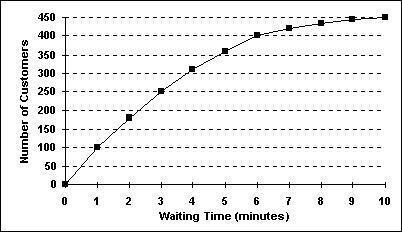
Ans: a
Response: See section 2 2 Quantitative Data Graphs
Difficulty: Medium
Learning Objective: 2.2: Construct different types of quantitative data graphs, including histograms, frequency polygons, ogives, dot plots, and stem-and-leaf plots, in order to interpret the data being graphed.
60. The staff of Mr. Wayne Wertz, VP of Operations at Portland Peoples Bank, prepared a cumulative frequency ogive of waiting time for walk-in customers.

The percentage of walk-in customers waiting more than 6 minutes was a) 22% b) 11% c) 67% d) 10% e) 75%
Ans: b
Response: See section 2.2 Quantitative Data Graphs
Difficulty: Medium
Learning Objective: 2.2: Construct different types of quantitative data graphs, including histograms, frequency polygons, ogives, dot plots, and stem-and-leaf plots, in order to interpret the data being graphed.
The percentage of walk-in customers waiting between 1 and 6 minutes was a) 22% b) 11% c) 37% d) 10% e) 67%
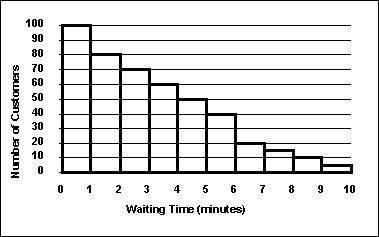

Ans: e
Response: See section 2.2 Quantitative Data Graphs
Difficulty: Medium a) 20 b) 30 c) 100 d) 180 e) 200
Learning Objective: 2.2: Construct different types of quantitative data graphs, including histograms, frequency polygons, ogives, dot plots, and stem-and-leaf plots, in order to interpret the data being graphed.
Approximately drive up ATM customers waited less than 2 minutes.
Ans: d
Response: See section 2.2 Quantitative Data Graphs
Difficulty: Medium
Learning Objective: 2.2: Construct different types of quantitative data graphs, including histograms, frequency polygons, ogives, dot plots, and stem-and-leaf plots, in order to interpret the data being graphed.
Approximately drive up ATM customers waited at least 7 minutes a) 20 b) 30 c) 100 d) 180 e) 200

Ans: b
Response: See section 2.2 Quantitative Data Graphs
Difficulty: Medium a) 50 b) 100 c) 700 d) 800 e) 890
Learning Objective: 2.2: Construct different types of quantitative data graphs, including histograms, frequency polygons, ogives, dot plots, and stem-and-leaf plots, in order to interpret the data being graphed.
64. The staff of Ms. Tamara Hill, VP of Technical Analysis at Blue Sky Brokerage, prepared a frequency histogram of market capitalization of the 937 corporations listed on the American Stock Exchange in January 2013.

Approximately corporations had capitalization exceeding $200,000,000.
Ans: b
Response: See section 2 2 Quantitative Data Graphs
Difficulty: Medium a) 50 b) 100 c) 700 d) 800 e) 900
Learning Objective: 2.2: Construct different types of quantitative data graphs, including histograms, frequency polygons, ogives, dot plots, and stem-and-leaf plots, in order to interpret the data being graphed.
65. The staff of Ms. Tamara Hill, VP of Technical Analysis at Blue Sky Brokerage, prepared a frequency histogram of market capitalization of the 937 corporations listed on the American Stock Exchange in January 2013.
Approximately corporations had capitalizations of $200,000,000 or less.
Ans: d
Response: See section 2.2 Quantitative Data Graphs
Difficulty: Medium a) A histogram b) bar chart c) A cumulative frequency distribution d) A frequency distribution e) A scatter plot a) histograms b) frequency polygons c) ogives d) pie charts e) scatter plots
Learning Objective: 2.2: Construct different types of quantitative data graphs, including histograms, frequency polygons, ogives, dot plots, and stem-and-leaf plots, in order to interpret the data being graphed.
66. An instructor has decided to graphically represent the grades on a test. The instructor uses a plus/minus grading system (i.e she gives grades of A-, B+, etc ). Which of the following would provide the most information for the students?
67. The staffs of the accounting and the quality control departments rated their respective supervisor's leadership style as either (1) authoritarian or (2) participatory Sixty-eight percent of the accounting staff rated their supervisor "authoritarian," and thirty-two percent rated him "participatory." Forty percent of the quality control staff rated their supervisor "authoritarian," and sixtypercent rated her "participatory " The best graphic depiction of these data would be two .
Ans: d
Response: See section 2.3 Qualitative Data Graphs
Difficulty: Hard
Learning Objective: 2.3: Construct different types of qualitative data graphs, including pie charts, bar graphs, and Pareto charts, in order to interpret the data being graphed.
68. A recent survey of U.S. automobile owners showed the following preferences for exterior automobile colors: a Frequency polygon b. Pareto chart c Bar graph d. Ogive e. Histogram
What type of graph is used to depict exterior automobile color preferences?
Ans: c
Response: See section 2.3 Qualitative Data Graphs
Difficulty: Easy
Learning Objective: 2.3: Construct different types of qualitative data graphs, including pie charts, bar graphs, and Pareto charts, in order to interpret the data being graphed.
69. A recent survey of U.S. automobile owners showed the following preferences for exterior automobile colors: a. White and Black b. White and Red/ Maroon c White and Blue d. White and Siver/Grey e. White and Other
What are the top two color preferences for automobiles?
Ans: a
Response: See section 2.3 Qualitative Data Graphs
Difficulty: Easy
Learning Objective: 2.3: Construct different types of qualitative data graphs, including pie charts, bar graphs, and Pareto charts, in order to interpret the data being graphed.
70. The following is a bar chart of the self-reported race for 189 pregnant women.

Approximately percent of pregnant women are African-American a) 20 b) 14 c) 5 d) 35 e) 50
Ans: b
Response: See section 2 3 Qualitative Data Graphs
Difficulty: Medium a) Only Baren share. b) Only Clemson lost market share. c) Alston lost market share. d) Baren lost market share. e) All companies lost market share
Learning Objective: 2.3: Construct different types of qualitative data graphs, including pie charts, bar graphs, and Pareto charts, in order to interpret the data being graphed.
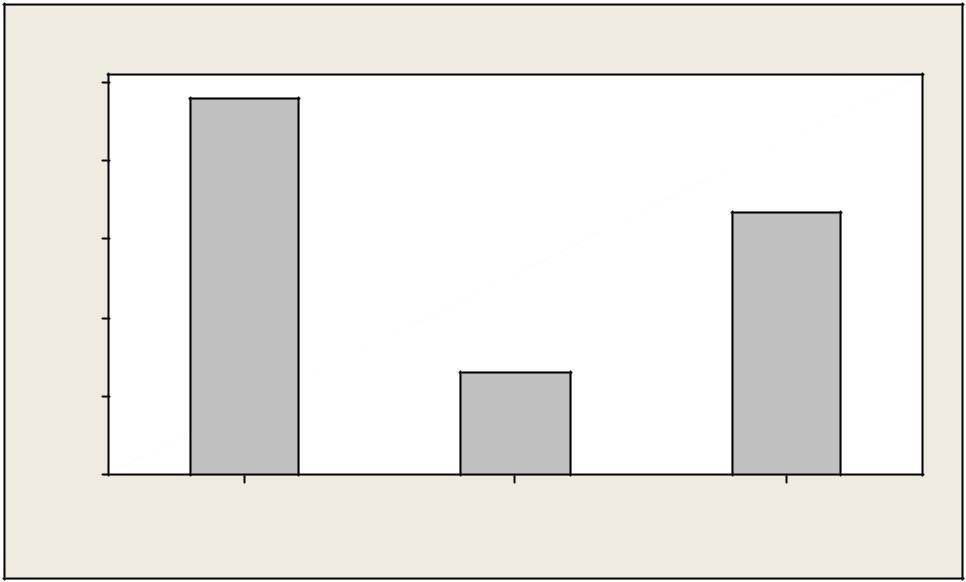
Which of the following is true?
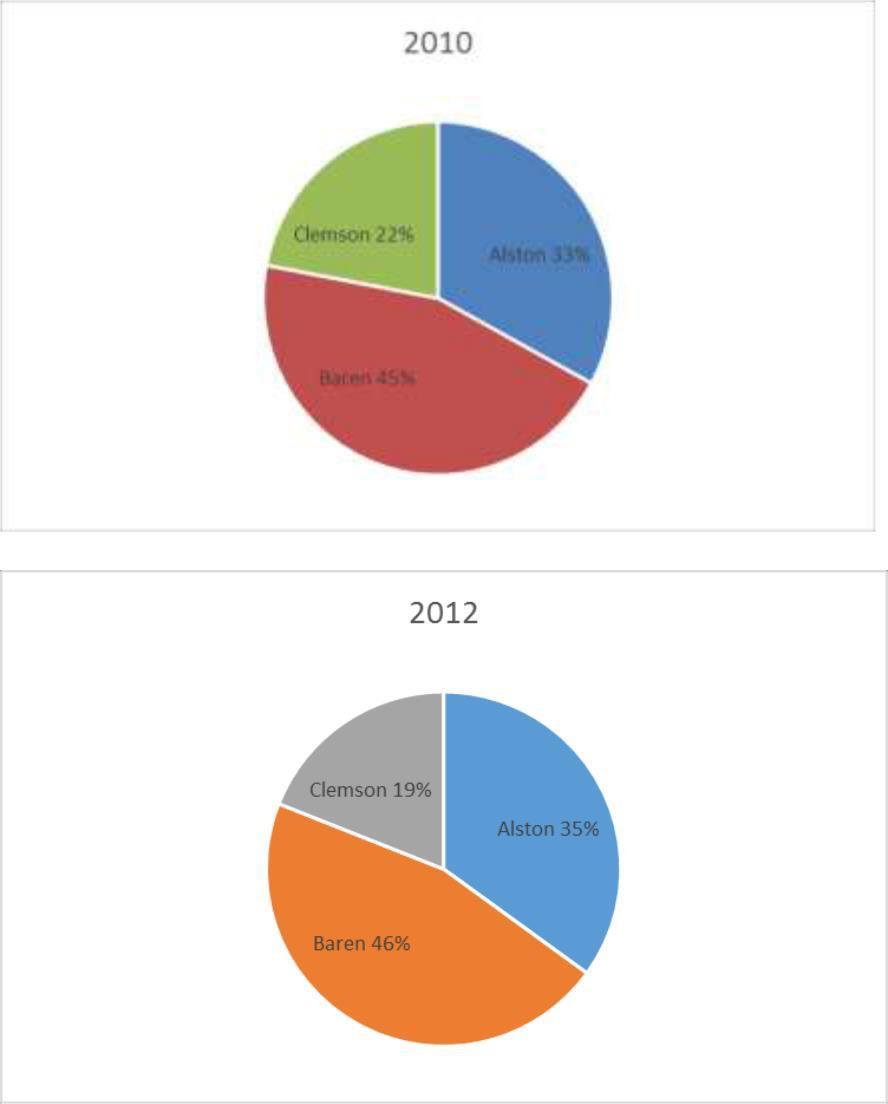
Ans: b
Response: See section 2.3 Qualitative Data Graphs
Difficulty: Medium a) $342 million b) $630 million c) $675 million d) $828 million e) $928 million
Learning Objective: 2.3: Construct different types of qualitative data graphs, including pie charts, bar graphs, and Pareto charts, in order to interpret the data being graphed.
72. The 2010 and 2012 market share data of the three competitors (Alston, Baren, and Clemson) in an oligopolistic industry are presented in the following pie charts. Total sales for this industry were $1.5 billion in 2010 and $1.8 billion in 2012. Clemson’s sales in 2010 were .
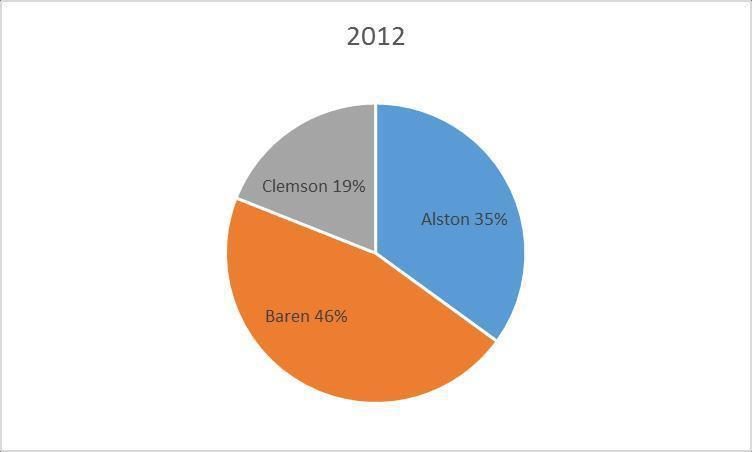
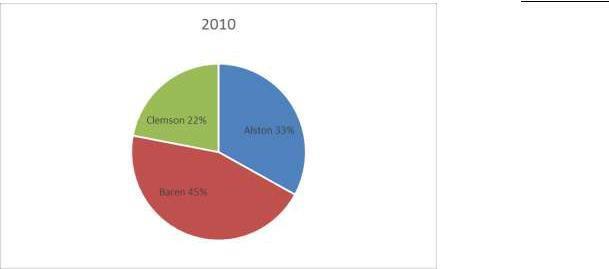
Ans: a
Response: See section 2.3 Qualitative Data Graphs
Difficulty: Medium
Learning Objective: 2.3: Construct different types of qualitative data graphs, including pie charts, bar graphs, and Pareto charts, in order to interpret the data being graphed.
73. The 2010 and 2012 market share data of the three competitors (Alston, Baren, and Clemson) in an oligopolistic industry are presented in the following pie charts. Total sales for this industry were $1.5 billion in 2010 and $1.8 billion in 2012. Baren’s sales in 2010 were a) $342 million b) $630 million c) $675 million d) $828 million e) $928 million
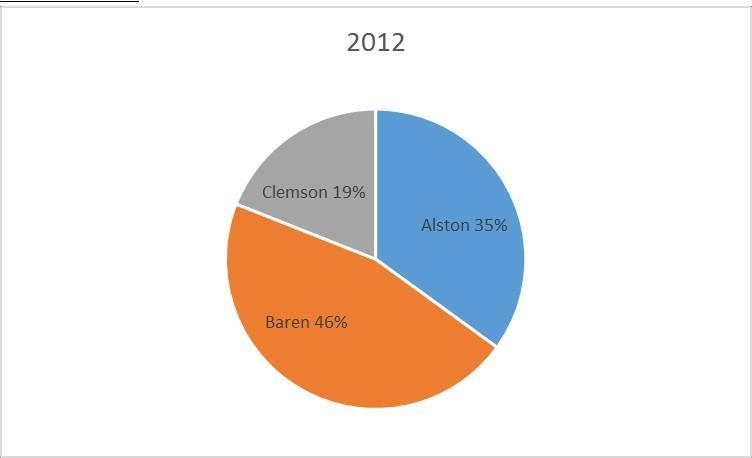
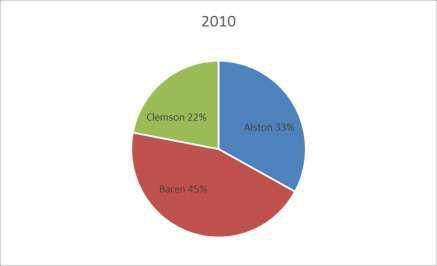
.
Ans: c
Response: See section 2.3 Qualitative Data Graphs
Difficulty: Medium a) Sales revenues declined at Clemson. b) Only Clemson lost market share. c) Alston gained market share d) Baren gained market share. e) Both Alston and Baren gained market share
Learning Objective: 2.3: Construct different types of qualitative data graphs, including pie charts, bar graphs, and Pareto charts, in order to interpret the data being graphed.
74. The 2010 and 2012 market share data of the three competitors (Alston, Baren, and Clemson) in an oligopolistic industry are presented in the following pie charts.
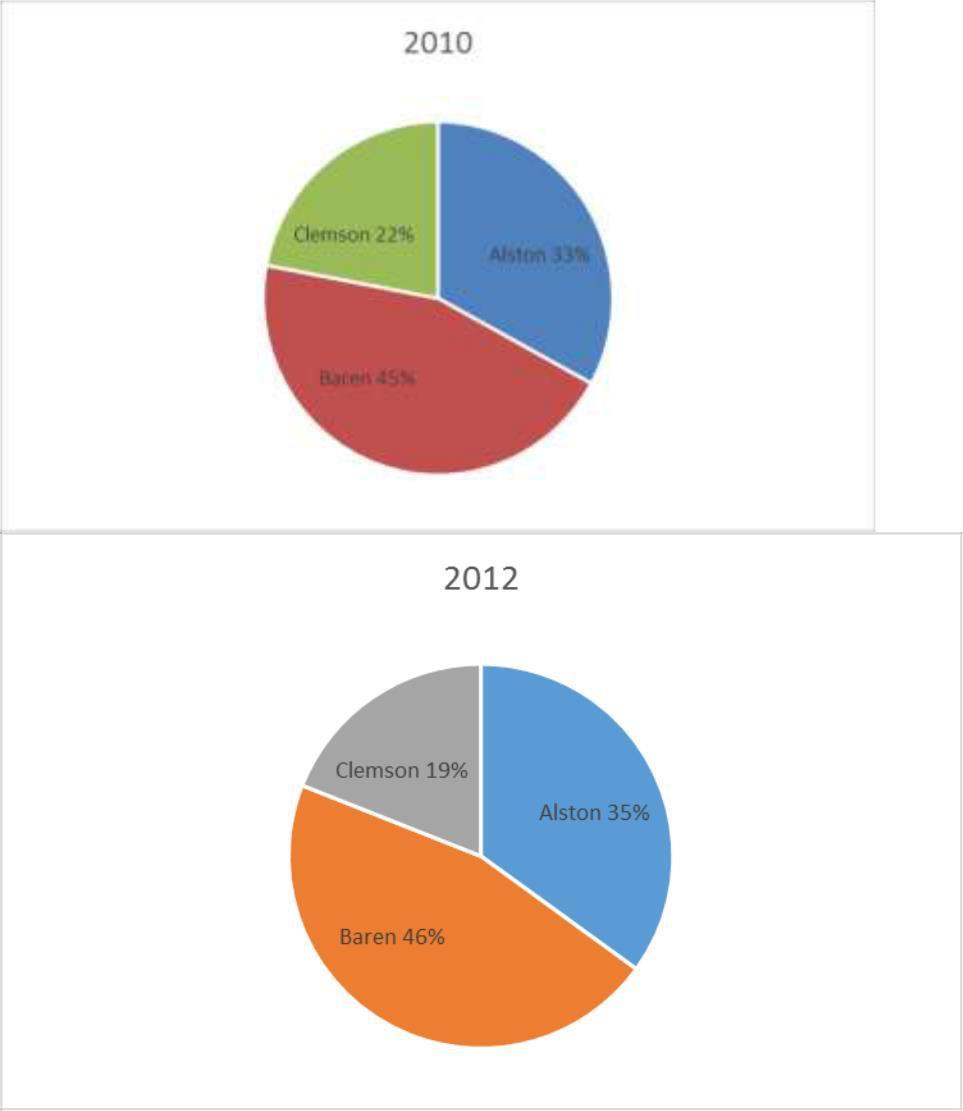
Which of the following may be a false statement?
Ans: a
Response: See section 2.3 Qualitative Data Graphs
Difficulty: Hard d) Cumulative Histogram Chart e) Line diagram
Learning Objective: 2.3: Construct different types of qualitative data graphs, including pie charts, bar graphs, and Pareto charts, in order to interpret the data being graphed.
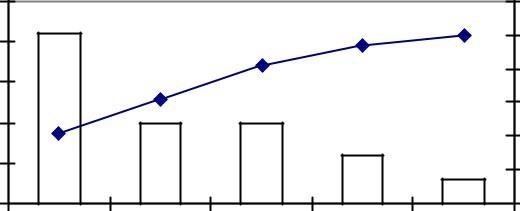
Ans: b
Response: See section 2.3 Qualitative Data Graphs
Difficulty: Medium
Learning Objective: 2.3: Construct different types of qualitative data graphs, including pie charts, bar graphs, and Pareto charts, in order to interpret the data being graphed.
76. According to the following graphic, the most common cause of PCB Failures is a
Cracked Bent Pin Wrong Missing Solder Trace Part Part Bridge Cause a) Cracked Trace b) Bent Pin c) Missing Part d) Solder Bridge e) Wrong Part
Ans: a
Response: See section 2.3 Qualitative Data Graphs
Difficulty: Medium
Learning Objective: 2.3: Construct different types of qualitative data graphs, including pie charts, bar graphs, and Pareto charts, in order to interpret the data being graphed


77. According to the following graphic, “Bent Pins” account for % of PCB Failures
Cracked Bent Pin Wrong Missing Solder Trace Part Part Bridge Cause
Ans: b
Response: See section 2 3 Qualitative Data Graphs
Difficulty: Hard
Learning Objective: 2.3: Construct different types of qualitative data graphs, including pie charts, bar graphs, and Pareto charts, in order to interpret the data being graphed
78. Suppose a market survey of 200 consumers was conducted to determine the likelihood of each consumer purchasing a new computer next year. The data were collected based on the age of the consumer and are shown below: a Younger consumers are more likely to purchase a computer next year. b. Older consumers are more likelyto purchase a computer next year. c. There does not appear to be a relationship between age and purchasing a computer. d. Individuals between 25 and 34 are most likely to purchase a new computer next year. e. None of the above statements are true.
Using the table above, which of the following statements is true?
Ans: d
Response: See section 2 4 Charts and Graphs for Two Variables
Difficulty: Easy
Learning objective: 2.4: Recognize basic trends in two-variable scatter plots of numerical data.
79. Suppose a market survey of 200 consumers was conducted to determine the likelihood of each consumer purchasing a new computer next year. The data were collected based on the income level of the consumer and are shown below: a. Wealthier consumers are more likelyto purchase a computer next year. b. Income does not seem to be related to likelihood of purchasing a computer next year. c The wealthier a consumer is the less likely they are to purchase a computer next year. d. Individuals with greater than $120K are least likely to purchase a new computer next year. e None of the above statements are true
Using the table above, which of the following statements is true?
Ans: b
Response: See section 2.4 Charts and Graphs for Two Variables
Difficulty: easy
Learning objective: 2.4: Recognize basic trends in two-variable scatter plots of numerical data.
80. The following graphic of residential housing data (selling price and size in square feet) is a a) scatter plot b) Pareto chart c) pie chart d) cumulative histogram e) cumulative frequency distribuion
Ans: a
Response: See section 2 4 Charts and Graphs for Two Variables
Difficulty: Medium
Learning objective: 2.4: Recognize basic trends in two-variable scatter plots of numerical data.
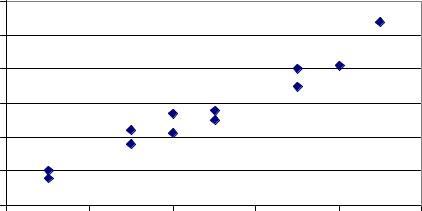
81. The following graphic of residential housing data (selling price and size in square feet) indicates a) an inverse relation between the two variables b) no relation between the two variables c) a direct relation between the two variables d) a negative exponential relation between the two variables e) a sinusoidal relationship between the two variables
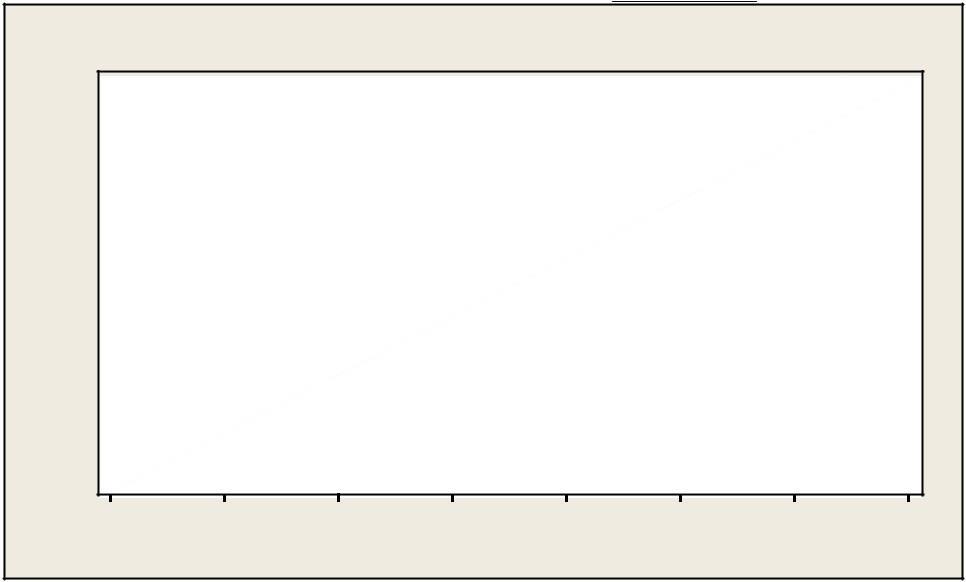
Ans: c
Response: See section 2 4 Charts and Graphs for Two Variables
Difficulty: Medium
Learning objective: 2.4: Recognize basic trends in two-variable scatter plots of numerical data
82. The following graphic of cigarettes smoked (sold) per capita (CIG) and deaths per 100K population from lung cancer (LUNG) indicates Scatterplot of LUNG vs CIG

